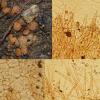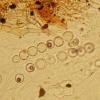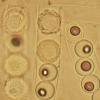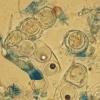
15-12-2025 15:48
 Danny Newman
Danny Newman
Melanospora cf. lagenaria on old, rotting, fallen

15-12-2025 15:54
 Johan Boonefaes
Johan Boonefaes
Unknown anamorph found on the ground in coastal sa

15-12-2025 21:11
 Hardware Tony
Hardware Tony
Small clavate hairs, negative croziers and IKI bb

15-12-2025 07:09
 Danny Newman
Danny Newman
indet. Rutstroemiaceae sp. on unk. fallen leavesMc

15-12-2025 07:05
 Danny Newman
Danny Newman
Pseudosclerococcum golindoi (det: Zotto)near Cosb

15-12-2025 11:49
 Danny Newman
Danny Newman
ITS sequences from the following two collections B

15-12-2025 12:34
 Danny Newman
Danny Newman
indet. Rhytismataceae on oak leafnear Purchase Roa

09-12-2025 12:06
 Andgelo Mombert
Andgelo Mombert
Bonjour,Je recherche l'article concernant Hypobryo
Trichophaea brunnea, plusieurs questions...
Beñat Jeannerot,
12-11-2010 20:29
 Bonjour à tous,
Bonjour à tous,Je trouve plusieurs exemplaires de cette Sphaerosporella brunnea sur une ancienne place à feu (3 ans) sous les branchages et autres ronces qui la recouvrent. Au côté de centaines de Trichophaea woolhopeia et de Tarzetta.
J'ai plusieurs questions :
- Qu'en est-il du nom de genre ? J'ai cru comprendre que tout tendait vers Trichophaea.
- Dans ce cas, ne doit pas t'on dire Trichophaea hinnulea, question de priorité ?
- Sont-elles seulement synonymes ? (brunnea et hinnulea). Je dois dire que les explications de Medardi tendant à conserver les deux espèces ne me convainquent guère...
Dernière question :
- J'ai un problème de spores. Tout va bien au niveau de l'excipulum, des poils de deux sortes, des mesures (poils et spores), etc.
Jusqu'à trouver des spores "bizarres" au milieu, comme entourées d'un périspore semblant ornementé de verrues ou de crêtes, agrandissant la spore jusqu'à 17-18 µm.
Je trouve ces spores dans certains asques en compagnie des autres. Il y a de 0 à 5 spores de la sorte mélangées avec des spores normales...
J'ai traité cinq apothécies et j'ai eu le problème dans deux.
Que sont ces spores ? Un problème ? Des jeunes non matures ?
Je n'en sais rien et ma question est peut-être idiote avec une solution simple mais je ne connais pas trop ce genre...
Ou alors, je me trompe carrément de genre, mais alors que faire des poils et autres données en corrélation...
Merci de votre avis,
Beñat
Apo + poils (2 sortes) + exc. ect.
Beñat Jeannerot,
12-11-2010 20:30
Ron Bronckers,
12-11-2010 22:48
Re:Trichophaea brunnea, plusieurs questions...
Hi Beñat,
Some of the questions you have can be answered by consulting Wang's article concerning Sphaerosporella taiwania (copy the link below to your browser)
http://digimuse.nmns.edu.tw/DigiMuse/NewModule.aspx?ObjectId=0b00000180034c2a&ParentID=0b00000180034c2a
See the drawings of the ascospores and have a look at the etymology.
The "false ornamentation" you observed is not uncommon in Trichophaea woolhopeia as well.
Ascospore walls of this species can sometimes loose tension and display a wrinkled appearance.
For a phylogenetic study dealing with the relationship between the genera Sphaerosporella and Trichophaea I refer to Perry et al. (2007). If you want I can send you a pdf-file of this article.
With kind regards,
Ron
Some of the questions you have can be answered by consulting Wang's article concerning Sphaerosporella taiwania (copy the link below to your browser)
http://digimuse.nmns.edu.tw/DigiMuse/NewModule.aspx?ObjectId=0b00000180034c2a&ParentID=0b00000180034c2a
See the drawings of the ascospores and have a look at the etymology.
The "false ornamentation" you observed is not uncommon in Trichophaea woolhopeia as well.
Ascospore walls of this species can sometimes loose tension and display a wrinkled appearance.
For a phylogenetic study dealing with the relationship between the genera Sphaerosporella and Trichophaea I refer to Perry et al. (2007). If you want I can send you a pdf-file of this article.
With kind regards,
Ron
Beñat Jeannerot,
13-11-2010 04:44

Re:Trichophaea brunnea, plusieurs questions...
Hi Ron,
Thanks for information. I actually viewed the same articles (Wang, Perry et al.).
Thank you for the explanation of spores lose tension. I've never seen that and I understand better now.
Regards,
Beñat
Thanks for information. I actually viewed the same articles (Wang, Perry et al.).
Thank you for the explanation of spores lose tension. I've never seen that and I understand better now.
Regards,
Beñat
Guy Garcia,
13-11-2010 15:31
Re:Trichophaea brunnea, plusieurs questions...
Je ne pense pas qu'il s'agisse d'uen fausse ornementation. A maturité les spores deviennent verruqueuses et ces verrues sont parfaitement mises en évidence avec le bleu cotton. Voici un montage photos d'une récolte effectuée en saulaie fangeuse au milieu du lit d'un ruisseau en partie asséché. J'ai également trouvé cette espèce sur terre brûlée et je n'ai observé aucune différence notable entre les différentes récoltes. Je me range donc à l'avis des mycologues anglais qui synnonymisent Sphaerosporella hinnulea et S. brunnea (me faudra d'ailleurs changer le nom de mon fichier !).
Amitiés, Guy
PS : j'enverrai le fichier plus tard car pour l'instant ça ne passe pas ?
Amitiés, Guy
PS : j'enverrai le fichier plus tard car pour l'instant ça ne passe pas ?
Guy Garcia,
13-11-2010 17:47
Ron Bronckers,
14-11-2010 12:16
Re:Trichophaea brunnea, plusieurs questions...
Hi Guy,
On your photos the spores indeed seem to be ornamented.
Perhaps Beñat can observe the same reaction in Cotton blue.
Unfortunately I do not have material of this species to examine.
The reason why I think it could be a "false ornamention" is that Wu & Kimbrough (1994) studied the ultrastructure of spore ontogeny in Sphaerosporella brunnea and did not mention the formation of ornaments. I have a copy of the article and can send you a scan if you are interested.
Nevertheless, it is very interesting and perhaps other mycologists had the same experience.
With kind regards,
Ron
On your photos the spores indeed seem to be ornamented.
Perhaps Beñat can observe the same reaction in Cotton blue.
Unfortunately I do not have material of this species to examine.
The reason why I think it could be a "false ornamention" is that Wu & Kimbrough (1994) studied the ultrastructure of spore ontogeny in Sphaerosporella brunnea and did not mention the formation of ornaments. I have a copy of the article and can send you a scan if you are interested.
Nevertheless, it is very interesting and perhaps other mycologists had the same experience.
With kind regards,
Ron
Peter Welt,
14-11-2010 13:04

Re:Trichophaea brunnea, plusieurs questions...
Hi Guy, Hi Ron,
I think that sometimes an ornament will be a sham, since the outer spore wall dissolves. A recent example can be seen here:
http://www.pilzepilze.de/cgi-bin/webbbs/pconfig.pl?noframes;read=198061
Peter
I think that sometimes an ornament will be a sham, since the outer spore wall dissolves. A recent example can be seen here:
http://www.pilzepilze.de/cgi-bin/webbbs/pconfig.pl?noframes;read=198061
Peter
Ron Bronckers,
14-11-2010 13:34
Re:Trichophaea brunnea, plusieurs questions...
Hello Peter,
An interesting example that can cause confusion whether spores are smooth or ornamented.
It can indeed be the result of a dissolving outer spore wall.
Another possibility in relation to Sphaerosporella brunnea is the presence of a perisporic sac (Wu & Kimbrough 1994) that becomes widely seperated from the epispore. Perhaps large clumps of wall material, condensing within the perisporic sac and precipitated onto the primary wall to form the epispore layer, are cyanophilic and look like ornaments.
The loosening of a perisporic sac can also be observed in Paratrichophaea boudieri (See Dissing & Raitviir 1973, as Cheilymenia albescens).
All the best,
Ron
An interesting example that can cause confusion whether spores are smooth or ornamented.
It can indeed be the result of a dissolving outer spore wall.
Another possibility in relation to Sphaerosporella brunnea is the presence of a perisporic sac (Wu & Kimbrough 1994) that becomes widely seperated from the epispore. Perhaps large clumps of wall material, condensing within the perisporic sac and precipitated onto the primary wall to form the epispore layer, are cyanophilic and look like ornaments.
The loosening of a perisporic sac can also be observed in Paratrichophaea boudieri (See Dissing & Raitviir 1973, as Cheilymenia albescens).
All the best,
Ron
Guy Garcia,
14-11-2010 23:05
Re:Trichophaea brunnea, plusieurs questions...
Chers Ron et Peter,
J'ai la publication de Wu & Kimbrough 1994. Il se peut que ces auteurs n'aient pas observé les spores dans le bleu cotton ! Mais je pense que sur leur photo n° 18 (surtout en bas à gauche), on voit bien que l'épispore commence à se fragmenter en petites "verrues" ou 'coussinets".
Il existe de nombreux cas où les spores ne deviennent ornementées qu'à pleine maturité et inversément certaines spores peuvent perdre leur ornementation en vieillissant. Dans quel cas s'agit-il d'une forme d'évolution ? Peut-être dans les deux ? L'avenir nous le dira certainement !
Ron, si je retrouve cette espèce je me ferai un plaisir de t'envoyer du matériel.
Voici une photo macro de la récolte dont j'ai envoyé les photos micro.
J'ai la publication de Wu & Kimbrough 1994. Il se peut que ces auteurs n'aient pas observé les spores dans le bleu cotton ! Mais je pense que sur leur photo n° 18 (surtout en bas à gauche), on voit bien que l'épispore commence à se fragmenter en petites "verrues" ou 'coussinets".
Il existe de nombreux cas où les spores ne deviennent ornementées qu'à pleine maturité et inversément certaines spores peuvent perdre leur ornementation en vieillissant. Dans quel cas s'agit-il d'une forme d'évolution ? Peut-être dans les deux ? L'avenir nous le dira certainement !
Ron, si je retrouve cette espèce je me ferai un plaisir de t'envoyer du matériel.
Voici une photo macro de la récolte dont j'ai envoyé les photos micro.
Ron Bronckers,
15-11-2010 11:53
Re:Trichophaea brunnea, plusieurs questions...
Hello Guy,
Indeed one has to be aware of the fact that the stage of ascospore development (immature, mature or over-mature) can display different characters and this can cause confusion.
Not only with ornaments but also the presence or absence of apiculi and/or collarettes.
At this moment I am working on a paper concerning the non-coprophilous Thecotheus phycophilus and the taxonomic value of these characters in this and other species of Thecotheus is also discussed.
What a beautiful photo of Spaerosporella brunnea in situ.
If you are able to retrieve this species I would love to have some material for examination and my herbarium.
With kind regards,
Ron
Indeed one has to be aware of the fact that the stage of ascospore development (immature, mature or over-mature) can display different characters and this can cause confusion.
Not only with ornaments but also the presence or absence of apiculi and/or collarettes.
At this moment I am working on a paper concerning the non-coprophilous Thecotheus phycophilus and the taxonomic value of these characters in this and other species of Thecotheus is also discussed.
What a beautiful photo of Spaerosporella brunnea in situ.
If you are able to retrieve this species I would love to have some material for examination and my herbarium.
With kind regards,
Ron
Beñat Jeannerot,
15-11-2010 17:25

Re:Trichophaea brunnea, plusieurs questions...
Adio et merci Guy,
Hi and many thanks Peter and Ron,
I attach a jpeg with spores in BC. It seems to be like a perisporic envelope, dissociated from the spore..., I don't know.
Ron,
I can do two things for you :
1. Send exsiccata
2. Return to the place and collect some fresh apothecia and send them in fresh state.
Please give me your postal address by mail,
Regards,
Beñat
Spores in BC
Hi and many thanks Peter and Ron,
I attach a jpeg with spores in BC. It seems to be like a perisporic envelope, dissociated from the spore..., I don't know.
Ron,
I can do two things for you :
1. Send exsiccata
2. Return to the place and collect some fresh apothecia and send them in fresh state.
Please give me your postal address by mail,
Regards,
Beñat
Spores in BC
Ron Bronckers,
15-11-2010 23:19
Re:Trichophaea brunnea, plusieurs questions...
Hello Beñat,
By judging your photo I also think, but I am no expert, that this probably is a loosening perisporic sac.
The ascospores examined by Guy are displaying ornaments which do not seem to be part of a loosenig outer wall or perisporic sac. The intense staining in CB also suggests that these are warts.
Both examples are very interesting and I would like to examine some apothecia if possible.
Beñat, thank you for offering to send me some apothecia, I give you my address.
All the best to everybody,
Ron
By judging your photo I also think, but I am no expert, that this probably is a loosening perisporic sac.
The ascospores examined by Guy are displaying ornaments which do not seem to be part of a loosenig outer wall or perisporic sac. The intense staining in CB also suggests that these are warts.
Both examples are very interesting and I would like to examine some apothecia if possible.
Beñat, thank you for offering to send me some apothecia, I give you my address.
All the best to everybody,
Ron



 13334.pdf
13334.pdf